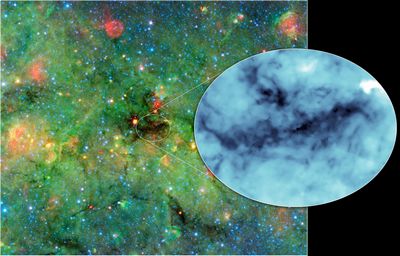Astronomers have found cosmic clumps so dark, dense and dusty that they throw the deepest shadows ever recorded. Infrared observations from NASA's Spitzer Space Telescope of these blackest-of-black regions paradoxically light the way to understanding how the brightest stars form.

Astronomers have found cosmic clumps so dark, dense and dusty that they throw the deepest shadows ever recorded. The clumps were discovered within a huge cosmic cloud of gas and dust.
The clumps represent the darkest portions of a huge, cosmic cloud of gas and dust located about 16,000 light-years away. A new study takes advantage of the shadows cast by these clumps to measure the cloud's structure and mass.
The dusty cloud, results suggest, will likely evolve into one of the most massive young clusters of stars in our galaxy. The densest clumps will blossom into the cluster's biggest, most powerful stars, called O-type stars, the formation of which has long puzzled scientists. These hulking stars have major impacts on their local stellar environments while also helping to create the heavy elements needed for life.
"The map of the structure of the cloud and its dense cores we have made in this study reveals a lot of fine details about the massive star and star cluster formation process," said Michael Butler, a postdoctoral researcher at the University of Zurich in Switzerland and lead author of the study, published in The Astrophysical Journal Letters.
The state-of-the-art map has helped pin down the cloud's mass to the equivalent of 70,000 suns packed into an area spanning about 50 light-years in diameter. The map comes courtesy of Spitzer observing in infrared light, which can more easily penetrate gas and dust than short-wavelength visible light. The effect is similar to that behind the deep red color of sunsets on smoggy days -- longer-wavelength red light more readily reaches our eyes through the haze, which scatters and absorbs shorter-wavelength blue light. In this case, however, the densest pockets of star-forming material within the cloud are so thick with dust that they scatter and block not only visible light, but also almost all background infrared light.
For a little more insight into the project see this: http://www.nasa.gov/jpl/spitzer/cosmic-clumps-20140521/#
